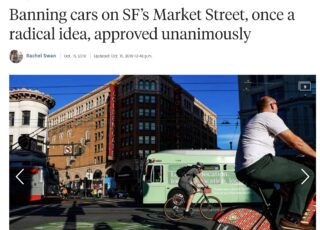
(Story in San Francisco Chronicle.)
It feels like the ground is shifting in America.
From the success of the War on Cars podcast, to a steady stream of national media stories that put cars in their place, ideas that have romanced transportation activists for years are beginning to seduce policymakers too.
Earlier this month we shared how New York City’s transportation department banned drivers from a major street in Manhattan in order to give bus operators and other non-driving people more room to breathe and move. The results of that project have been overwhelmingly positive.
And on Tuesday we learned that the San Francisco Municipal Transportation Agency voted unanimously to prohibit private cars on a 2.2-mile stretch of Market Street. The vote culminated a 10-year campaign to improve the health of what locals call their “civic backbone”. Market is a major east-west thoroughfare that bisects the city and connects thousands of people and destinations to the San Francisco Bay.
Among the notable aspects of this news is the project’s broad support. In a letter to the SFMTA, San Francisco’s Mayor London Breed expressed her “strong support” and urged them to begin the first phase of the project immediately. (It’s worth noting that while Market is an important artery in San Francisco’s road network, it’s far from a major driving route. It already has protected bike lanes, rail transit, and bus-only lanes. It’s much more akin to Portland’s transit mall streets of SW 5th and 6th than West Burnside.)
Advertisement
Check out how private vehicles (which SFMTA defines as “ersonal cars, trucks, vans, scooters and motorcycles, including those operated by Uber, Lyft and similar companies”) will be circulated in the new plan:
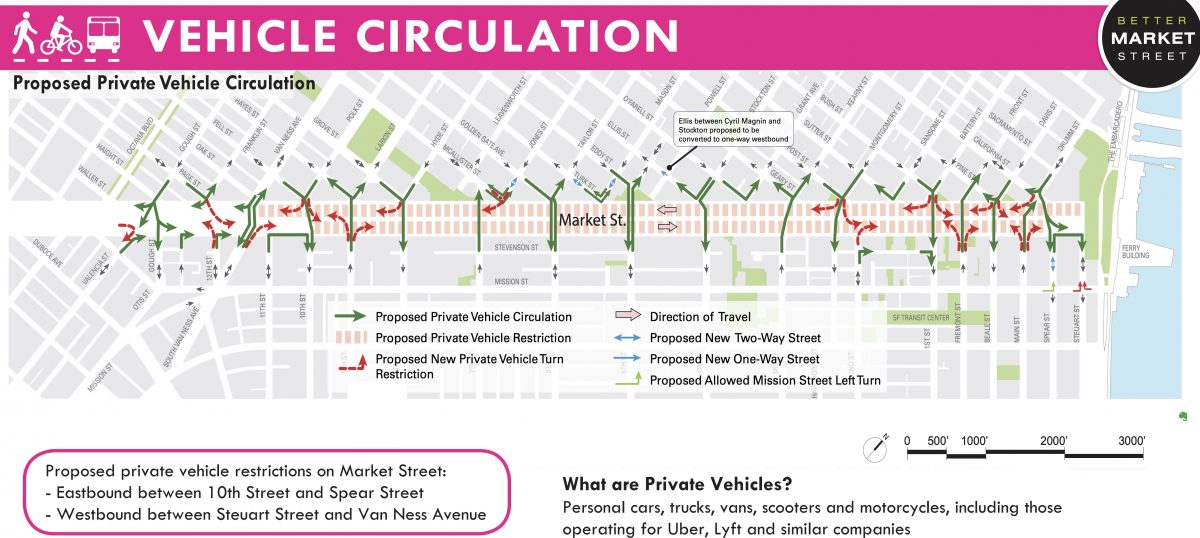
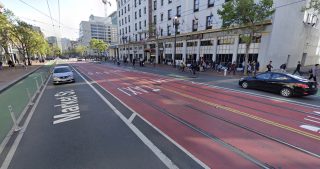
This great news has many people wondering which street in their city should be carfree. In Portland, we’re long overdue in following New York City and San Francisco’s lead. Despite tremendous momentum for carfree streets (did you know Portland held a Carfree Day in 2006 and hosted the World Carfree Conference in 2008?), we’ve taken only baby steps.
As many of you might recall from previous posts on this topic, my money is on NW 13th. Last week I heard folks are meeting about a NW 13th “promenade” proposal that would create multi-block carfree sections. I’ll have an update on that very soon. In terms of comparisons to Market Street, I think the “transit mall” on 5th and 6th is similar and should be a no-driving no-brainer.
Portland’s city council has at least two members — Jo Ann Hardesty and Chloe Eudaly — who’ve professed a desire to have fewer cars downtown. We’d need just one more believer for a majority.
What do you think will be our first major street to go carfree? If the decision was up to you, which street would you choose? Now is the time to make something happen. Perhaps PBOT’s Streets 2035 plan is one place to start the conversation?
Learn more about the Market Street project on Streetsblog SF and at BetterMarketStreetSF.org.
— Jonathan Maus: (503) 706-8804, @jonathan_maus on Twitter and jonathan@bikeportland.org
— Get our headlines delivered to your inbox.
— Support this independent community media outlet with a one-time contribution or monthly subscription.


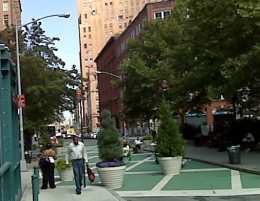
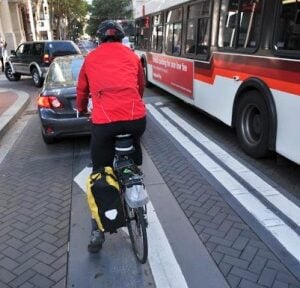
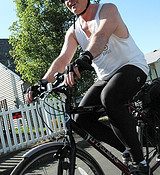
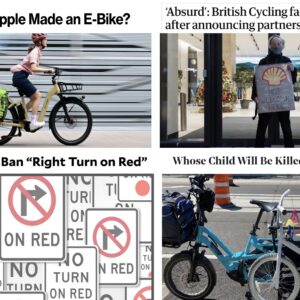
Thanks for reading.
BikePortland has served this community with independent community journalism since 2005. We rely on subscriptions from readers like you to survive. Your financial support is vital in keeping this valuable resource alive and well.
Please subscribe today to strengthen and expand our work.
ALL of Portland’s most popular commercial corridors should be car-free. NW 23rd, NW 21st, Mississippi, Mississippi, etc.
Buses would still be allowed through—we’d just reclaim all of the parking spots for more street space, outdoor seating, bike lanes, etc, which would effectively double the amount of space dedicated for people.
May I like this twice? Definitely NW 23rd. To you pull it off you need: more transit to connect to hotels and population centers, taxi stands, more frequent streetcars, and marketing as a destination with local character and multiple attractions. When businesses see that it’s in their interest they’ll get on board.
I would pick NW 23rd out of self interest because sometimes I bike there and it’s awful for that. In fairness this benefit should be offered to any community or district that wants it. If you make it work in one place others will want to get on board.
NW 13th: I do not understand why anybody drives there at all. We’ve already put in the stick, it’s presently really hard to drive or park in NW. Time for the carrot.
NW 13th is the biggest easy win and no brainer. But SE Division, SE Hawthorne, SE Woodstock, NE Albina, SW 5th and 6th. The list goes on.
Perhaps seasonally. I can’t imagine that open space being utilized to the extent it would be in the summer.
Even if the volume of foot traffic is considerably less in the winter, if it’s worth being utilized by cars year-round, it’s worth being utilized by people year round.
Director Park should be a no-brainer. Also I think I read here somebody proposed SW Ankeny as well.
SW Ankeny is already almost half car-free and doesn’t go anywhere or connect to anything. So, that makes it a likely candidate. 🙂
I really hope you’re right about 13th ave. I’ve been thinking about that ever since my initial visit to a First Thursday event.
No question Market Street is San Francisco’s transit spine…two subways, surface streetcar, numerous buslines and protected bikeways. As I recall from my years living in SF (1970-80), few people, other than lost tourists, used “The Slot” in their private rig. Our Transit Mall is the closest thing to it, less a subway or two!
Where I would like us to follow SF’s example is in freeway decommissioning. The Embarcadero Freeway…with some help from the ’89 earthquake… got replaced with a fine boulevard with a streetcar line down the middle. But it was SF city policy that it be removed long before ’89.
Let’s decommission the Marquam Bridge and I-5 between it and I-84. Make I-5 through the Rose Quarter a continuation of I-84 and really bury it where its below grade. I-405 can be designated I-5 and maybe even get another lane as long as it too is buried as per Mayor Katz’s idea in the ’90s.
But where will all that traffic go? AWAY! “Build it and they will come” has an inverse law, “remove it and they will go away!” People will change modes, relocate, change jobs; in short we humans can and do adjust, and if the planet is to survive, we must.
Hear hear! Lenny.
My personal favorite: NE Alberta, between 15th and 33rd-ish. Lots of stores, lots of foot traffic, little parking that would be lost and the street ends on 33rd anyways.
Ok, thumbs up I guess, but consider the neighborhood. Last Thursday is a bit of a nightmare if you live between Prescott and Killingsworth. Car Hell.
The Disneyfication of Portland is well underway:
https://www.oregonlive.com/business/2016/07/portland_hotel_boom_increasing.html
–and if people show up to fill those rooms we need viable low-impact ways to move them around as well as some actual local business and (small-c) culture that goes beyond big retail, sports franchises, and entertainment emporiums. As Portland shifts towards a tourist / visitor economy we’ll need good fast frequent transit that goes to interesting places. Or else Uber.
I’d like to see pop-up express buses between known attractions and concentrations of people. For example, a weekend bus with two or three pickups downtown and a drop in the Jade District, with maybe a loop shuttle or jitneys around the drop off. You might think the Jade District doesn’t need promotion but the real product is transit. There’s an idea that transit is gray and slow and we need to get out of that rut.
Don’t tell Taz Loomans – https://bikeportland.org/2015/04/27/column-fellow-bike-lovers-need-talk-car-shaming-139892
Normally I am against road diets and street closures (except on established bikeways) but this sounds like a good idea.
I would suggest no cars on the streets the MAX runs on.
“Normally I am against road diets and street closures”
Why?
Because the roads look just fine as they are. Suggesting they need to lose anything is road shaming. Try to adopt a “Road Positive” outlook, and stop shaming roads that have extra capacity.
Park Ave should definitely be a bike/pedestrian street all the way through. A perfect tie-in to the proposed Green Loop.
Mayor London Breed is a woman, and I think she uses she/her/hers pronouns.
Congrats to SF! (This has been 50+ years in the making. And makes me what to re-visit SF and spend my tourist money there!!)
And the key takeaway here is – historically the most successful pedestrianized roadways are those that have been converted due to being “too successful” and over crowded thus rationing of space is needed vs. road widening.
Sort of like Portland’s transit mall. Oh, wait, it was car free from 1980 to 2009 and then was reopened to traffic when MAX was added.
Another piece of low hanging fruit is the two blocks of 1st Ave in Old Town where it’s still possible to drive. It would be very easy to extend the sidewalk to the edge of the MAX tracks. My understanding is that the team behind the proposed PAE Living Building at SW 1st and Pine looked into doing this (presumably at the project’s expense) but PBOT development review said no.
Now if only Portland had a functioning transit system like SF, so people wouldn’t have to make a choice between driving across town and spending several hours of their workday on the bus.
Removing roads before a viable alternative exists is really putting the cart before the horse.
While I agree that traffic can certainly slow down the buses, the problem is bigger than that. A 13 mile trip from my home to work takes 90 minutes by bus/train when there’s no traffic. Traffic can increase the time by about 10 minutes each way, but the base time of 3 hours per day to go to work and back is ridiculous. Unless that gets fixed, other initiatives to get people to stop driving are doomed to failure.
Again, the chicken and the egg. Posted transit schedules are languid because they have to be at least fairly plausible allowing for slow boarding and operation in mixed traffic. A bus doesn’t get significantly faster even when traffic is light because they can’t outrun that schedule. To speed them up we need stop improvements, prepaid fares, signal priority, etc. If we really care about transit everything that happens to a bus should be dialed in.
Our long bus routes could be merged quickly into a few major streets with dedicated lanes to penetrate denser traffic. The inner neighborhoods could be served with short lines, jitneys, frequent crosstown buses, or even excellent walking and biking routes. It’s really dispiriting to encounter a four lane street that you can’t cross without a visa. Who would ever walk?
For me transit is most useful to get the tourist experience in my own town, or maybe to get through the hell of the SW. I support better buses and trains because I see them as the great hope for getting more SOVs off the roads. Fewer cars = safer bikes, faster buses, more effective freight movement…faster buses also mean you get more frequent service with the same amount of equipment and labor cost.
I have to agree. Getting stuck behind traffic and/or sandwiched between parked cars on the Park blocks is maddening. The park blocks should be for people, not carbon-spewing machines.
I like several of the suggestions. I’m not proposing a particular location, but I’d love to see Portland get some true urban piazzas/squares. By that I mean a place where you can walk out of buildings directly onto a car-free space, that’s a real space, not just a wide sidewalk, or even a directional street.
SW Ankeny comes close in some ways, but it’s a narrow directional path, not a square. The PSU brick plaza and the PSU Park Blocks are skewed too much towards being campus environments. The main ones–Pioneer Courthouse Square, Keller Fountain, the Park Blocks–are cut off from surrounding buildings by vehicle streets.
So any street closures that could go towards creating real plazas would be great, even if they’re not closed to vehicles 24/7. Even eliminating vehicles from 2 of 4 sides would dramatically change the characters of most of our “squares”.
You can get pizza in a piazza or a plaza.
While I’m not in love with the design, that was the intent of Con-way Block 290:
http://www.nextportland.com/2017/08/15/block-290-and-slabtown-square/
The project was approved in 2017, and then appealed by the neighborhood to City Council, LUBA and the Oregon Court of Appeals. I just heard that their appeal to the Oregon Supreme Court was denied, so it’s possible that it will move forward now.
Thanks for that example. It certainly does do what I mentioned about stepping directly into a space from surrounding buildings. It’s pretty antiseptic though, when it’s the same building on three sides. Also, it looks like it’s a dead end–more of a courtyard than a plaza. I guess I need to add to my criteria–a real piazza should be enterable (?) from several directions. It’s a great experience to be walking along a street, then turning a corner and having the street space open up, with people walking in and out of it from several directions.
Some of Portland’s existing public spaces could have that feeling if vehicle traffic were removed from a couple sides. A street like NW 13th could also have that feeling, where you’re walking through the neighborhood, then the street you’re on opens up into a wide pedestrian-only space, where the space is part of a route but also a destination in itself.
Along those lines, I’d love to see more superblocks (like the ones surrounding Pettygrove and Lovejoy Parks), across downtown. Closing 2nd and 3rd, then all the non-bridge E/W streets (from 1st to 4th) to motor vehicles would dramatically enhance the livability of downtown.
Pizza in Rome is typically square.
For some odd reason, I really like Yamhill between 3rd and 1st. Except for the crossing of 2nd, it’s just MAX tracks through there, and with the cobblestones, walking through there in the morning gives me a real old-timey vibe.
Those car-free streets should also ban bicycles and scooters as well so pedestrians can finally feel safe.
I’m not totally against that idea, but would reserve that to the open spaces/plazas.
Burnside. From Beaverton to Gresham. Because it’s about time.
2nd choice is SW Jefferson & SE Division, all the way to 176th.
With all the grand concepts being tossed about, stop also to consider the details.
Driveways. The vision of ‘car free’ does not match the reality on the ground. All private property is required to have access to the public road system, not perfect access, but some access. This is a clear point of law. Partial vehicle access will be part of any initial test projects, even if it is only for a block or two.
Traffic diversion. Some of the roads on the lists move upwards of 1,500 cars in the peak hours in one direction, not to mention the 10,000-15,000 daily volumes. There will need to be a transition, and potentially increases in capacity on parallel routes (intersections at least), to successfully achieve such goals. One of the unintended trade-offs will likely be increased traffic on roads already considered dangerous, creating a stronger barrier than currently exists for people crossing those busy streets. One of the benefits of a grid is dispersal of traffic. I for one do not want to copy the LA, Florida, or Atlanta models of road design.
Yes, there are to consider when it comes to implementation, but it’s a bit disappointing that you start from a position of why car free streets can’t be done (though a good illustration of why Portland is no longer a leader.) In the Downtown / Pearl area there are very few buildings with garage access from the core of NW 13th Ave or the Park Blocks. Neither play an important role in the transportation system either.
The implementation challenges on a street like NW 21st or Mississippi would be greater for sure, but they’re also not streets that are particularly important for regional travel either. Many of the buildings on those streets are older buildings without parking, and the newer ones tend to have garage access from the intersecting streets.
It’s true that the need to maintain driveway access limits our ability to do long stretch of truly car-free streets. But the simple solution is to force turns every block or two. Toronto recently forced all traffic except transit vehicles to turn right at every major street along King St in their downtown, and it works great. Taxis turn on from one street, pick people up, and turn at the next street. This kind of thing could work in many places around Portland, including commercial main streets.
100% car free also doesn’t have to be the goal. as long as the balance is shifted far enough toward anybody outside a car, limited car access doesn’t have to be detrimental.
My thoughts may be a bit more aggressive than most, but I’d like to see car-free streets at a periodic interval throughout the urban environment (up to 52nd?). This could mean car-free every 10th street, or it could be as dense as every 5th street. The roads take up some much real estate! Let’s turn them into something more healthy and enjoyable.
If Metro is serious about the Division Transit Project, then they should do this for SE Division.
The Park Blocks, both North and South, are a logical set of streets for fewer or no cars.
Its the “Green Loop” alignment, so something must be in the works. I think the paving treatment at Director’s Park helps calm, if not reduce auto traffic, but more can be done. Make Park Avenue into a linear park!
Throughout the city, particularly close in where higher density housing is coming on strong, we need more public spaces…parks, plazas, or squares as in the Pearl District. In the midst of all those new apartments at E. Burnside, Sandy and 12th Avenue is an entire block given over to storing vehicles. Make it a big square for all the folks who will be soon living there.
It’s not downtown, Lombard through St Johns is a great candidate.
How about first banning bikers who refuse to stop at stop signs and injure pedestrians? No? I thought so. The white entitlement is strong with PDX bikers
That’s already banned. And I’ve never heard of one person ever who thinks it’s OK to injure pedestrians. And the enforcement level seems fine too, since it hardly ever happens.
Why go there? Rolling or creeping past a stop sign is a basic human tendency not unique to bike riders. Take your clipboard out and stand by one of those red octogons. Let us know what you see.
Long term I’d make the diagonals car free; Sandy and Foster create the most unsafe intersections for all users, and by providing a straight line towards downtown they encourage driving. Make those streets bus, bike and pedestrian ways, and give them priorities at the intersections.